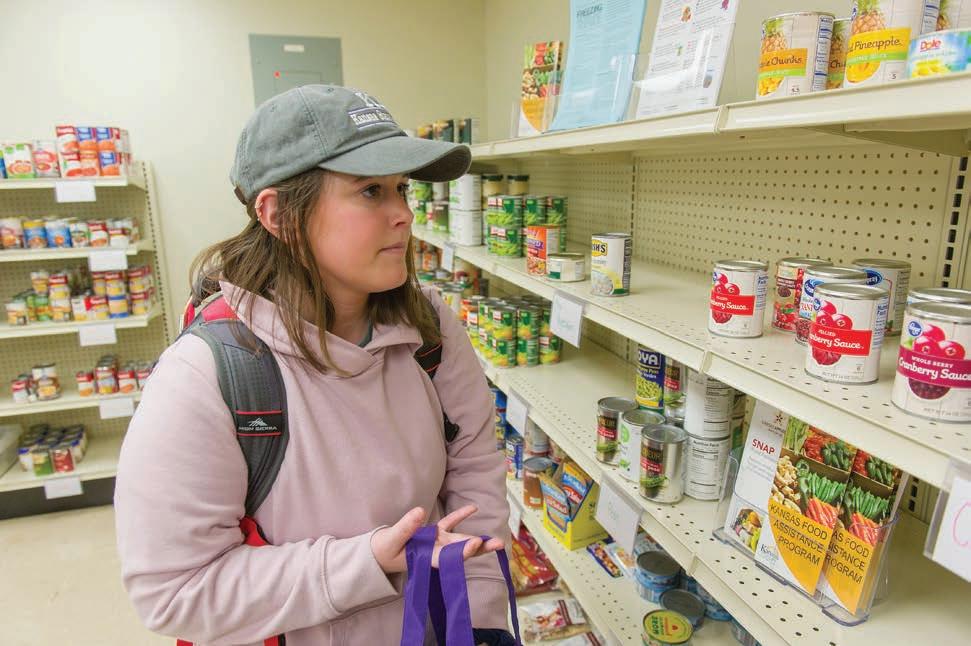
7 minute read
KANSAS ON DISPLAY
For 50 years, Konza Prairie has been a blend of nature and research at K-State
BY TIM SCHRAG ’12
Advertisement
PHOTOS BY BARB SCHMIDT VAN SLYKE ’78, KONZA PRAIRIE BIOLOGICAL STATION
Just south of Manhattan, Big Bluestem grass sways and rustles in the breeze. There’s a stillness here no matter the season.

In the distance a bison herd quietly grazes. In the air glides a turkey vulture or two. Meadowlarks singing their song can be found here. The clear waters of the Kings Creek nurture the area and sometimes set the soundtrack. Whitetail deer can be found prancing about here too. Kansas — and more specifically the Flint Hills — are on display for anyone who wants to see it at the Konza Prairie.
Konza Prairie Biological Station was established in 1971 and is jointly owned by Kansas State University and The Nature Conservancy. For 50 years, Konza has been a place of both research and respite.
“Grasslands, in general, cover 30% or so of the Earth’s surface, so they’re really important and understudied. They’re also some of the most endangered ecosystems on the planet. In North America, only about 4% of what was originally tallgrass prairie remains,” said John Blair, university distinguished professor of biology and director of Konza Prairie Biological Station. “Konza Prairie, our little 8,600 acres of tallgrass prairie, is the most intensively studied piece of grassland in the world.”
Operating as a research field station managed by K-State’s Division of Biology, scientists have conducted long-term and short-term research at Konza since its establishment. However, Blair said, for the past 40 years of operation the station has been part of a long-term ecological research program that measures the health of the prairie. Essentially scientists are measuring everything about it from the soil chemistry to water chemistry, to the plant, bird, mammal and invertebrate communities that inhabit the prairie.
“We’ve built up now a 40-plus year record of how all of those things respond to natural variability, to management, and to the environmental changes that are happening around us,” Blair said. “And all of that is the kind of information that you need if you want to sustainably manage and conserve these grasslands for future generations.”
More than 1,900 scientific papers have been produced based on findings from Konza. Additionally, more than 300 graduate students have received their master’s and/or doctoral degrees based on research from the station. Blair said more than 60 K-State researchers from five colleges and 12 departments are involved in studies on the prairie. Also, more than 25 institutions have active projects.
“For the past half-century, Konza has been owned - excepting 900 acres - by the Conservancy and managed for research, study and education by K-State,” said Rob Manes ’82, director of The Nature Conservancy, Kansas. “This unique cooperative venture is recognized around the world Konza Prairie has maintained a herd of bison since 1987 when Fort Riley Military Reservation donated 30 animals. Today the K-State herd numbers are close to 300.


Each year researchers and staff at Konza Prairie burn portions of the watershed to investigate long-term prairie health.
Wolly Verbena is a drought-resistant prairie plant with purple flowers and roots that can descend to 12 feet.

Fog on the Prairie Blue False Indigo Hulbert Center in snow


To nd out more about the Konza Prairie, visit konza.ksu.edu

for its prized scientific opportunities.”
Since 1980, Konza Prairie investigators have received more than $90 million in extramural research awards, primarily from the National Science Foundation, the U.S. Department of Energy and the U.S. Department of Agriculture.
“The Konza Prairie Biological Station plays a critical role in K-State’s research enterprise,” said David Rosowsky, K-State’s vice president for research. “This milestone anniversary marks five decades of important research that has produced a rich and detailed understanding of how long-term environmental change and land management affect grasslands and water systems.”
Researchers are looking at a wide variety of topics that have practical applications, Blair said. Fire ecology is important for managing prairies, for example, and restoration has applications in places where the tallgrass prairie once thrived.
“How do we rebuild something that looks like a native prairie that has the diversity of plants and animals and insects in those places? Restoration ecology is a really hot topic,” Blair said. “And we’re doing some pioneering research here in how best to restore the diversity that characterizes native prairies. It’s a challenge. It’s really not easy.”
Burning prairie land is a common practice for land management. Konza has multiple studies looking into best practices of burning.
“The invasion of woody plants is negatively impacting both the economic and the ecological values of the prairie,” said Jill Haukos, education coordinator for the station. “If we don’t do something to fight back against that we could potentially lose our tallgrass prairie, and this highlights the necessity of fire as a management tool.”
Haukos runs the education program, which helps the public learn about the prairie. For the past 25 years, the Konza Environmental Education Program, known as KEEP, offers programming for all ages.
The program has several goals: • To bring children to the tallgrass prairie to increase their understanding of this remarkable ecosystem and to instill a sense of place and pride in their environment. • To allow students to participate in handson ecological research to increase their knowledge of the scientific process and the significance of research. • To share with the public the latest scientific research and emphasize the importance of research in grassland conservation and management.
“I’ve got 2,500 to 3,000 students a year K-12, coming out here and learning about their ecosystem,” Haukos said. “They come out here and we teach them, ‘This is yours, people. This is your responsibility. Come learn about it, because you’re going to need to take care of it.’”
The station was the vision of Lloyd Hulbert, a K-State professor of ecology. Haukos said a group of researchers within the Division of Biology in the 1950s saw the need for land to conduct research on the surrounding tallgrass prairie. Hulbert spearheaded the efforts to secure such land.
Haukos said Hulbert went to the administration, the Board of Regents, the state legislature and Washington, D.C., to try to secure funding to purchase a parcel of prairie.
“They all said, ‘Love it. Great idea, no money.’ There was really only one organization that gave him any hope,” Haukos said. “The Nature Conservancy was interested in preserving large swaths of prairie, and Lloyd Hulbert’s idea for a tallgrass prairie biological station in Kansas was the kind of initiative they were looking to support.”
Enter philanthropist Katharine Ordway, who provided funds for the purchase of the initial parcel of land. Ordway asked that the space be named after a native people and thus Konza was selected to honor the Kansa or Kaw people. After her death several adjoining tracts, including the 2,923-hectare historic Dewey Ranch, were purchased between 1971 and 1979. Haukos said in all Ordway bought about 31,000 or so acres of prairie land in five different states, all of which is part of what’s called the Ordway Prairie Preserve.
The Nature Conservancy also helped Konza Prairie establish three hiking loops approximately 2.6, 4.5 and 6 miles in length that are open to the public year-round. The trail hosts 45,000 visitors annually, rivaling many state parks in visitation. The Kansas Trail Guide published by University Press of Kansas refers to the trails as great scenic vistas of pristine tallgrass prairie.
“Though recreation is somewhat outside the mission of both TNC and K-State’s research arm, both organizations recognize the great importance the Konza trails hold to people who benefit from the trails and support the work of the Conservancy and Kansas State,” Manes said.
Konza Barn Kings Creek in Snow


The hills of the Konza Prairie in May Sunflower



Hikers on the trail Eastern Purple Coneflower The view on the trail












